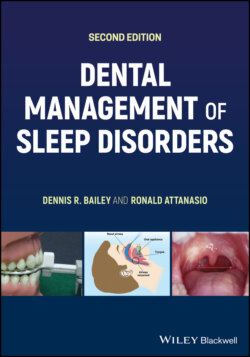Читать книгу Dental Management of Sleep Disorders - Ronald Attanasio - Страница 34
Neurobiology of Sleep
ОглавлениеSleep and wakefulness are basically driven by the brain, including the brainstem, and is based on a very complex series of ongoing events governed by EEG changes and activity as well as a variety of neurotransmitters. Curiosity about sleep dates back to the Greeks, into the Middle Ages and the Renaissance. Lucretius, a poet and philosopher, proposed that sleep was “the absence of wakefulness” [19]. In the last 100 years, science has attempted to better define and understand sleep. In 1917, Constantin von Economo described a condition termed encephalitis lethargica that was associated with an epidemic of influenza from 1916 to 1928 [20]. Those impacted suffered from insomnia or hypersomnia during the acute phase of the illness. It was determined that the hypothalamus sustained injury and those with insomnia had lesions in the anterior part and those with hypersomnia had lesions in the posterior part. This led to the recognition of the hypothalamus as the center involved with sleep.
Figure 2.3 Sleep over the decades.
Table 2.1 Recommended hours of sleep by age.
Source: Adapted from Hirshkowitz et al. [18].
| Age | Hours of sleep needed |
|---|---|
| 4–11 months | 12–15 |
| 1–2 years | 11–14 |
| 3–5 years | 10–13 |
| 6–13 years | 9–11 |
| 14–17 years (teens) | 8–10 |
| 18–25 years | 7–9 |
| 26–64 years | 7–9 |
| 65+ years (older adults) | 7–8 |
In 1928, Hans Berger used surface EEG and found that this activity was different for sleep compared to the conscious state [21]. Continuous research and investigation into the mysteries of sleep is ongoing. In the 1950s significant discoveries occurred at the University of Chicago, first in 1953 with the discovery of REM sleep by Asernisky and Kleitman and a few years later Dement and Kleitman described REM and NREM cycling.
At this time humans exist in either a state of wakefulness, in REM sleep, or in NREM sleep. As Dr. Lee‐Chiong has proposed: “Perhaps waking, REM sleep, and NREM sleep are merely electroencephalographic representations of existence” [22]. Understanding the primary neuronal areas of the brain that control the sleep and wake state are (Figure 2.4):
Hypothalamus: Key area of neurons in the brain that is involved with mainly regulating sleep and to some degree wakefulness
Suprachiasmatic nucleus (SCN): Considered as the pacemaker for the CR, for body temperature regulation, hormonal release, and behavioral control. Receives input from the light–dark cycle and influences the hypothalamus.
Brainstem – ascending reticular activating system (ARAS): This is the neuromodulating system for wakefulness. Within this area is the locus coeruleus (LC).
The eye–retinohypothalamic tract: Presence of light through the eye via the retina and the optic nerve influences the SCN, hypothalamus, and the pineal gland.
Pineal gland: The source of melatonin that is a modulator for sleep based on the light–dark cycle.
There are many other neuronal areas in the brain that release the various neurotransmitters that may be reviewed and studied in the references cited.
Figure 2.4 The brain. CC, corpus callosum; HT, hypothalamus; ON, optic nerve; RAS, reticular activating system (brain stem); SCN, suprachiasmatic nucleus; PIT, pituitary; THAL, thalamus; LC, locus coeruleus; C, cerebellum; MB, mammillary bodies; PG, pineal gland; HIP, hippocampus; AM, amygdala.
Table 2.2 Neurotransmitters of sleep and wake.
| Wake alerting | Sleep promoting |
|---|---|
| Histamine | Adenosine |
| Acetylcholine | GABA |
| Dopamine | Glycine |
| Glutamate | Melatonin |
| Hypocretin (orexin) | (A hormone) |
| Norepinephrine | Serotonin (5HT) |
| Serotonin (5HT) |
